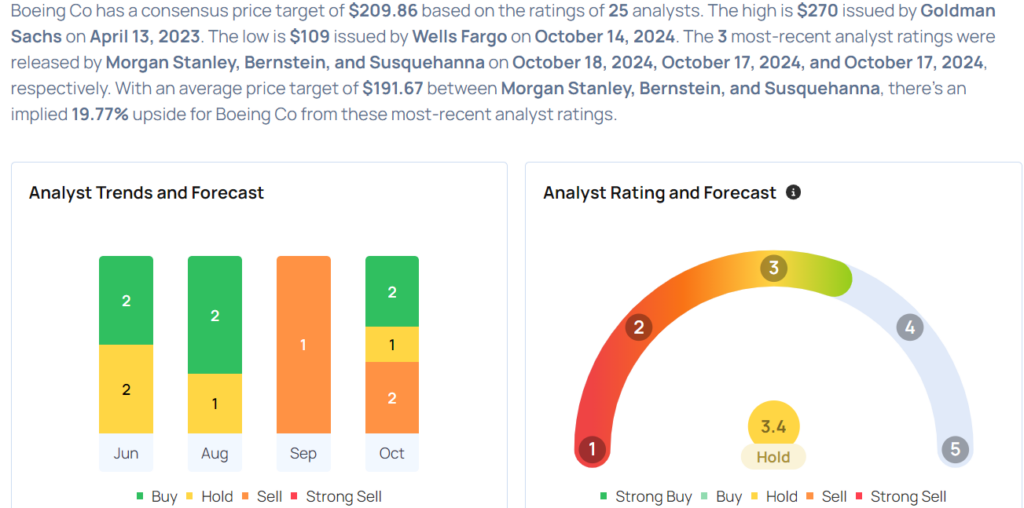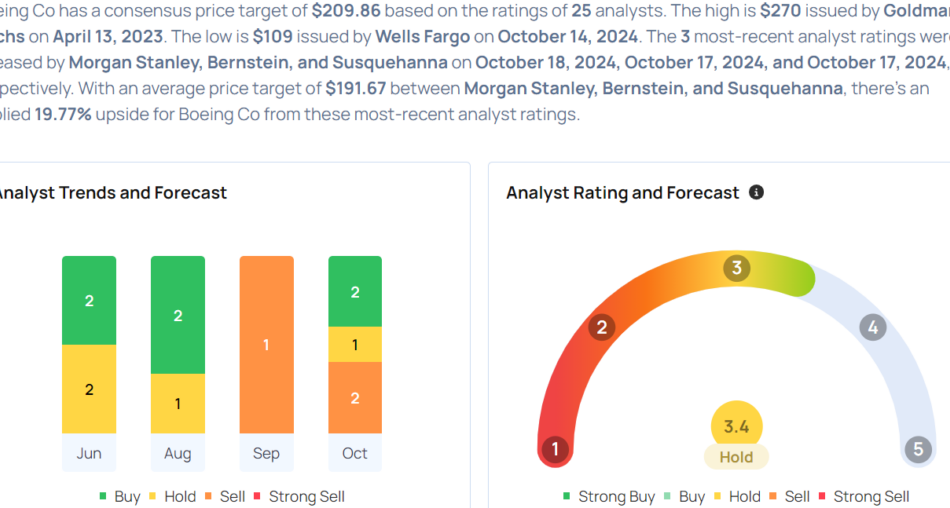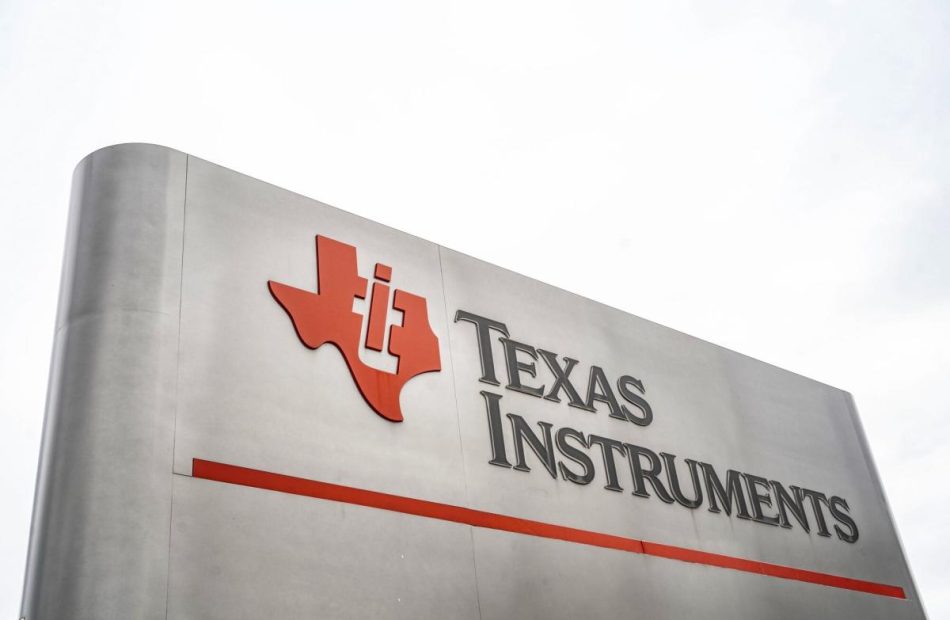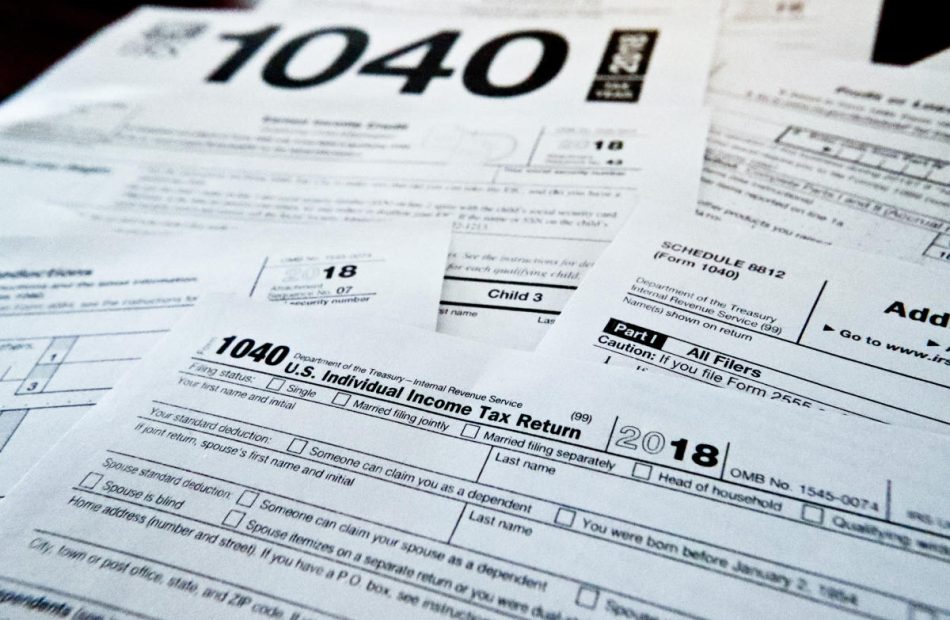Boeing Gears Up For Q3 Print; Here Are The Recent Forecast Changes From Wall Street's Most Accurate Analysts
The Boeing Company BA will release earnings results for its third quarter, before the opening bell on Wednesday, Oct. 23.
Analysts expect the Arlington, Virginia-based company to report a quarterly loss at $10.52 per share, versus a year-ago loss of $10.48 per share. Boeing projects to report revenue of $6.06 billion for the quarter, compared to $17.82 billion, compared to $16.51 billion a year earlier, according to data from Benzinga Pro.
According to Reuters, Boeing plans to issue around $10 billion in new shares and $5 billion in mandatory convertible bonds, a hybrid bond that converts into equity at a predetermined date. The plane maker also filed regulatory documents indicating it could raise up to $25 billion in stock and debt.
Boeing shares rose slightly to close at $159.88 on Tuesday.
Benzinga readers can access the latest analyst ratings on the Analyst Stock Ratings page. Readers can sort by stock ticker, company name, analyst firm, rating change or other variables.
Let’s have a look at how Benzinga’s most-accurate analysts have rated the company in the recent period.
- Morgan Stanley analyst Kristine Liwag maintained an Equal-Weight rating and cut the price target from $195 to $170 on Oct. 18. This analyst has an accuracy rate of 71%.
- Citigroup analyst Jason Gursky maintained a Buy rating and slashed the price target from $224 to $209 on Oct. 15. This analyst has an accuracy rate of 83%.
- TD Cowen analyst Cai Rumohr maintained a Buy rating and cut the price target from $200 to $190 on Oct. 14. This analyst has an accuracy rate of 77%.
- JP Morgan analyst Seth Seifman maintained an Overweight rating and lowered the price target from $235 to $195 on Oct. 14. This analyst has an accuracy rate of 85%.
- Wells Fargo analyst Matthew Akers maintained an Underweight rating and cut the price target from $110 to $109 on Oct. 14. This analyst has an accuracy rate of 78%.
Considering buying BA stock? Here’s what analysts think:

Read This Next:
Market News and Data brought to you by Benzinga APIs
© 2024 Benzinga.com. Benzinga does not provide investment advice. All rights reserved.
Tesla Bitcoin Wallet Activity A Rotation, Not A Sell-Off, Says Analytics Firm As Elon Musk-Headed EV Giant Expected To Reveal Q3 Numbers
Elon Musk’s EV juggernaut Tesla Inc. TSLA was reportedly still in possession of its Bitcoin BTC/USD holdings, and the recent transfers were nothing but reallocation.
What Happened: On-chain analytics firm Arkham Intelligence posted an update on X on Tuesday, saying, “We believe that the Tesla wallet movements that we reported on last week were wallet rotations with the Bitcoin still owned by Tesla.”
About 11,509 BTCs, worth $771.8 million as of this writing, were moved by a wallet linked to Tesla to several wallets last week, sparking speculation in the market.
As per the latest update, the holdings were distributed across seven wallets that hold between 1100 and 2200 BTC.
“Some have speculated that this is movement to a custodian, for example, to secure a loan against the BTC,” Arkham added.
Tesla didn’t immediately return Benzinga’s request for comment on the transfers.
© 2024 Benzinga.com. Benzinga does not provide investment advice. All rights reserved.
Benzinga simplifies the market for smarter investing
Trade confidently with insights and alerts from analyst ratings, free reports and breaking news that affects the stocks you care about.
Texas Instruments Says It’s Nearing Recovery After Sales Slump
(Bloomberg) — Texas Instruments Inc. Chief Executive Officer Haviv Ilan said that customers are working through excess inventory and the timing is right for an order recovery following eight straight quarters of revenue declines.
Most Read from Bloomberg
Speaking on a conference call after delivering third-quarter results, Ilan said that three of TI’s main markets have already begun to rebound, but its biggest sales sources — industrial and automotive chips — are still suffering from a glut of inventory.
“We really need the broad industrial market and the automotive market to join,” he said. When asked to predict a rebound he replied, “It’s about time, but we haven’t seen it yet.”
Investors seized on the optimistic tone and sent the shares up about 3% in late trading. The stock had been down after Texas Instruments posted its results, which included a tepid forecast for the fourth quarter.
Sales in that period will be $3.7 billion to $4 billion, the company said. Analysts, on average, estimated $4.08 billion, according to data compiled by Bloomberg. Profit will be $1.07 to $1.29 a share, compared with an average projection of $1.35.
The Dallas-based company is the biggest maker of chips that perform simple but vital functions in a wide range of electronic devices. While the chipmaker’s executives are typically reluctant to give industrywide long-term projections, investors use its forecasts as indicators of demand across the industry.
Texas Instruments shares, up 14% this year, closed at $193.97 on Tuesday.
In the third quarter, revenue fell 8.4% to $4.15 billion, marking the eighth consecutive contraction. Analysts projected $4.12 billion. Profit was $1.47 a share, compared with an estimate of $1.37 per share.
Heading into Texas Instruments earnings, chip companies had been giving conflicting signals about the industry. Equipment maker ASML Holding NV reported weak orders for its gear and said customers are becoming more cautious. Taiwan Semiconductor Manufacturing Co., meanwhile, delivered a strong forecast. For both companies, demand for advanced chips used in artificial intelligence computing is a bright spot.
The biggest chunk of Texas Instruments’ revenue comes from makers of industrial equipment and vehicles, which together account for more than 70% of sales. Its products provide a variety of functions — some as simple as registering button pushes and converting power.
The 2025 tax brackets are here. How much will you owe?
The IRS just released its inflation-adjusted tax brackets for 2025 — and it’s the smallest increase in four years. Income thresholds for each tax bracket will rise by about 2.8% in the new year, compared to 5.4% in 2024 and 7% for 2023. The modest increase reflects the cooling pace of inflation since the peak years of the pandemic.
The tax brackets for 2025 apply to taxes due in 2026. To calculate your taxes due on April 15, 2025, you’ll use 2024 tax brackets.
Understanding how tax brackets work can get a bit confusing, but essentially, your income is taxed at several different rates that increase as you earn more money. Let’s say, for example, that you’re a single filer who earns $50,000 in 2025. Even though you’d fall into the 22% tax bracket, you won’t pay a flat tax rate of 22%.
Instead, your income would be taxed as follows:
-
10% of the first $11,925 = $1,192.50
-
12% of the next $36,529 ($48,475-$11,926) = $4,383.48
-
22% of the last $1,524 ($50,000-$48,476) = $335.28
Total tax bill: $5,911.26
Even though you’re in the 22% tax bracket, your effective tax rate is just under 12%. You may be able to lower your tax bill even more if you qualify for tax credits and deductions.
Read more: 2024-2025 federal income tax brackets and rates
The standard deduction is an amount you can subtract from your taxable income, even if you don’t have deductible expenses. Most taxpayers opt for the standard deduction vs. itemizing.
The standard deduction will increase to the following amounts in 2025:
-
Single filers: $15,000
-
Heads of household: $22,500
-
Married couples filing jointly: $30,000
-
Married couples filing separately: $15,000
Going back to our example of a single filer who earns $50,000 in 2025: If you took the standard deduction of $15,000, your taxable income would drop to just $35,000 ($50,000-$15,000).
The IRS also announced a few more inflation adjustments that are coming next year.
The earned income tax credit, or EITC, is a tax credit aimed at helping low- to moderate-income workers and their families. The maximum credit for taxpayers with three or more qualifying children jumps to $8,046 in 2025, up from $7,830 in 2024. You may be able to qualify for a smaller credit if you have fewer than three children (or even no tax dependents at all), depending on your income.
A health flexible spending account, or FSA, is an employer-sponsored account that lets you set aside pre-tax money for IRS-approved health expenses. The contribution limit for health FSAs will increase by $100, from $3,200 in 2024 to $3,300 in 2025.
Cathie Wood-Led Ark Dumps $5.8M Worth Of Robinhood Shares Amid Forecasts Of A Potential Rally From Analysts
On Tuesday, Cathie Wood’s Ark Invest made significant trades, with a notable sell-off in Robinhood Markets Inc HOOD.
The Robinhood Trade
Ark Invest sold a total of 210,483 shares of Robinhood from its ARK Innovation ETF ARKK and ARK Next Generation Internet ETF ARKW, marking a significant reduction in its holdings of the stock. The value of this trade, based on Robinhood’s closing price of $27.41 on Tuesday, is approximately $5.8 million. This move comes amidst a backdrop of changing analyst forecasts for Robinhood, with some predicting a potential rally of around 12% for the stock.
However, this isn’t the first time that Ark Invest has reduced its stake in Robinhood. Earlier in the week, Cathie Wood had already trimmed Ark’s holdings in the company, sparking discussions among investors about whether to follow her lead or stay put. As Benzinga noted, the reasons behind selling a stock can be varied and often more nuanced than market reactions might suggest.
Other Key Trades:
- Ark Invest sold 34,392 shares of Moderna Inc (MRNA) from its ARKG fund. The firm bought shares of Tempus AI Inc (TEM) for its ARKG fund and ARKK fund.
- Ark purchased 7,609 shares of CRISPR Therapeutics AG (CRSP) for its ARKG fund and also for its ARKK fund. The investment manager also added shares of Cerus Corp (CERS) to its ARKG fund and ARKK funds.
Read Next:
This story was generated using Benzinga Neuro and edited by Shivdeep Dhaliwal
Market News and Data brought to you by Benzinga APIs
© 2024 Benzinga.com. Benzinga does not provide investment advice. All rights reserved.
Do Billionaires Israel Englander and Ken Griffin Know Something? Each Just Bought This Plagued Value Stock.
Each quarter, investment firms managing over $100 million are required to file a form 13F with the Securities and Exchange Commission (SEC). These filings provide valuable insight into which stocks the “smart money” investors on Wall Street are buying and selling.
Last quarter, Ken Griffin’s Citadel and Israel Englander’s Millennium Management both bought Pfizer (NYSE: PFE) stock. Investing in Pfizer might look like a questionable move as shares are down nearly 30% over the last three years and the stock has woefully underperformed the S&P 500 throughout 2024.
While Pfizer’s current picture looks a little cloudy, there are a couple of potential catalysts that could fuel a new wave of growth for the company if well executed. Could Griffin and Englander be onto something here? Let’s dig in and explore what an investment in Pfizer might look like.
Pfizer is one of the most recognized pharmaceutical companies in the world. With such a rich history of developing blockbuster drugs across several pockets of the healthcare landscape, what could possibly be plaguing Pfizer stock right now?
Well, for starters, the company’s primary source of growth in recent years can be traced to the COVID-19 pandemic. Pfizer was a leading force against COVID-19, and the company’s vaccines and other solutions sparked record growth. However, while there is still a need for such medications, demand for Pfizer’s COVID-19 treatments has cratered as peak pandemic days appear to be in the rearview mirror.
Nevertheless, I see two potential areas that could help spark a turnaround for Pfizer.
In late 2023, Pfizer closed on a massive acquisition. The company bought an oncology business called Seagen for the not-so-low price tag of $43 billion. The acquisition helped bolster Pfizer’s clinical pipeline and augmented the company’s oncology-specific treatments.
According to Pfizer’s publications, the company hopes to have at least eight blockbuster oncology medications by 2030 — up from five today. If Pfizer executes on this vision, the company could stand to generate billions of dollars in sales across a host of different medications, helping set it up for sustained and robust growth.
Another lucrative opportunity for Pfizer right now is in the weight loss arena. Glucagon-like peptide-1 (GLP-1) agonists such as Ozempic and Mounjaro are revolutionizing the diabetes and chronic weight management market. While Novo Nordisk and Eli Lilly are the two big forces in the GLP-1 realm right now, there are a number of other pharma companies looking to get involved, including Pfizer.
Oil-Dri Corp of America Vice President Operations Trades $239K In Company Stock
A significant insider buy by Aaron Christiansen, Vice President Operations at Oil-Dri Corp of America ODC, was executed on October 21, and reported in the recent SEC filing.
What Happened: In a significant move reported in a Form 4 filing with the U.S. Securities and Exchange Commission on Monday, Christiansen purchased 3,500 shares of Oil-Dri Corp of America, demonstrating confidence in the company’s growth potential. The total value of the transaction stands at $239,505.
In the Tuesday’s morning session, Oil-Dri Corp of America‘s shares are currently trading at $69.5, experiencing a up of 1.56%.
Discovering Oil-Dri Corp of America: A Closer Look
Oil-Dri Corp of America develops, manufactures, and markets sorbent products made predominantly from clay. Its absorbent offerings, which draw liquid up, include cat litter, floor products, toxin control substances for livestock, and agricultural chemical carriers. The company has two segments based on the different characteristics of two primary customer groups namely Retail and Wholesale Products Group and Business to Business Products Group. The company’s products are sold under various brands such as Cat’s Pride, Jonny Cat, Amlan, Agsorb, Verge, Pure-Flo, and Ultra-Clear.
Understanding the Numbers: Oil-Dri Corp of America’s Finances
Revenue Growth: Oil-Dri Corp of America displayed positive results in 3 months. As of 31 July, 2024, the company achieved a solid revenue growth rate of approximately 5.88%. This indicates a notable increase in the company’s top-line earnings. In comparison to its industry peers, the company stands out with a growth rate higher than the average among peers in the Consumer Staples sector.
Analyzing Profitability Metrics:
-
Gross Margin: The company faces challenges with a low gross margin of 29.04%, suggesting potential difficulties in cost control and profitability compared to its peers.
-
Earnings per Share (EPS): Oil-Dri Corp of America’s EPS is significantly higher than the industry average. The company demonstrates a robust bottom-line performance with a current EPS of 1.26.
Debt Management: With a below-average debt-to-equity ratio of 0.34, Oil-Dri Corp of America adopts a prudent financial strategy, indicating a balanced approach to debt management.
Market Valuation:
-
Price to Earnings (P/E) Ratio: The current P/E ratio of 12.6 is below industry norms, indicating potential undervaluation and presenting an investment opportunity.
-
Price to Sales (P/S) Ratio: With a lower-than-average P/S ratio of 1.38, the stock presents an attractive valuation, potentially signaling a buying opportunity for investors interested in sales performance.
-
EV/EBITDA Analysis (Enterprise Value to its Earnings Before Interest, Taxes, Depreciation & Amortization): Oil-Dri Corp of America’s EV/EBITDA ratio, lower than industry averages at 7.72, indicates attractively priced shares.
Market Capitalization Analysis: Below industry benchmarks, the company’s market capitalization reflects a smaller scale relative to peers. This could be attributed to factors such as growth expectations or operational capacity.
Now trade stocks online commission free with Charles Schwab, a trusted and complete investment firm.
The Importance of Insider Transactions
It’s important to note that insider transactions alone should not dictate investment decisions, but they can provide valuable insights.
Within the legal framework, an “insider” is defined as any officer, director, or beneficial owner holding more than ten percent of a company’s equity securities as per Section 12 of the Securities Exchange Act of 1934. This includes executives in the c-suite and major hedge funds. These insiders are mandated to disclose their transactions through a Form 4 filing, to be submitted within two business days of the transaction.
The initiation of a new purchase by a company insider serves as a strong indication that they expect the stock to rise.
However, insider sells may not always signal a bearish view and can be influenced by various factors.
Important Transaction Codes
Delving into transactions, investors typically prioritize those unfolding in the open market, as precisely outlined in Table I of the Form 4 filing. A P in Box 3 indicates a purchase, while S signifies a sale. Transaction code C signals the conversion of an option, and transaction code A denotes a grant, award, or other acquisition of securities from the company.
Check Out The Full List Of Oil-Dri Corp of America’s Insider Trades.
Insider Buying Alert: Profit from C-Suite Moves
Benzinga Edge reveals every insider trade in real-time. Don’t miss the next big stock move driven by insider confidence. Unlock this ultimate sentiment indicator now. Click here for access.
This article was generated by Benzinga’s automated content engine and reviewed by an editor.
Market News and Data brought to you by Benzinga APIs
© 2024 Benzinga.com. Benzinga does not provide investment advice. All rights reserved.
These Are the 5 Most Shorted Stocks in the S&P 500 Index. The Bears Are Wrong About 1 of Them.
With the S&P 500 now up more than 23% this year, some investors are eyeing individual names in the broader benchmark index that look overvalued and might be at risk of correction. These select investors hope to enact a short sale that can help them access outsized profits.
Shorting is a standard practice typically seen on Wall Street when investors or firms borrow shares at a certain price and then immediately sell the borrowed shares in the market. These investors hope the share price drops so they can repurchase the shares for less and then return them to the borrower, pocketing the price difference for themselves as profit. For some, shorting is viewed as a villainous practice. For others, it’s considered a healthy part of a free market that prevents valuations from getting too frothy.
Shorting can be risky if not hedged properly. Stocks can, in theory, rise to infinity, so investors who bet wrong can lose their shirts if the stock price keeps going up. Retail investors monitoring their portfolios should take notice if one of their stocks has a big short position against it. Seeing one may suggest they reexamine their thesis on the stock and double-check that they are not missing anything.
Here are the five most shorted stocks in the S&P 500. Most are on this list for good reason, but the bears are wrong about one of them.
Super Micro Computer (NASDAQ: SMCI), the designer and manufacturer of computer servers and storage systems, has slightly more than 21% of its available shares sold short — the highest in the S&P 500, according to StatMuse. Like most great stocks this year, Super Micro has been a huge beneficiary of the artificial intelligence boom. Companies running machine learning and other types of AI models use Super Micro’s computers and storage systems for storing the massive quantities of data required to make AI possible. Its stock price is up 66% this year.
However, a firm with a reputation for shorting stocks, Hindenburg Research, issued a short report against Supermicro in August, alleging accounting improprieties that Supermicro says are false or inaccurate. The Securities and Exchange Commission did charge the company with “widespread accounting violations” back in 2018. Super Micro saw its valuation balloon earlier this year to close to 93 times earnings, but it now trades at about 24 times earnings.
Close to 16% of the float is being sold short on the cloud-based human resource platform Day Force (NYSE: DAY). The stock is down more than 4% this year. Day Force is a software-as-a-service company that helps companies manage all aspects of human resources, from payroll to benefits to hiring. The company trades at a big valuation of more than 210 times earnings and 35 times forward earnings, well ahead of peers.
Lower-priced new cars are gaining popularity, and not just for cash-poor buyers
DETROIT (AP) — Had she wanted to, Michelle Chumley could have afforded a pricey new SUV loaded with options. But when it came time to replace her Chevrolet Blazer SUV, for which she’d paid about $40,000 three years ago, Chumley chose something smaller. And less costly.
With her purchase of a Chevrolet Trax compact SUV in June, Chumley joined a rising number of buyers who have made vehicles in the below-average $20,000-to-$30,000 range the fastest-growing segment of the nation’s new-auto market.
“I just don’t need that big vehicle and to be paying all of that gas money,” said Chumley, a 56-year-old nurse who lives outside Oxford, Ohio, near Cincinnati.
Across the industry, auto analysts say, an “affordability shift” is taking root. The trend is being led by people who feel they can no longer afford a new vehicle that would cost them roughly today’s average selling price of more than $47,000 — a jump of more than 20% from the pre-pandemic average.
To buy a new car at that price, an average buyer would have to spend $737 a month, if financed at today’s average loan rate of 7.1%, for just under six years before the vehicle would be paid off, according to Edmunds.com, an auto research and pricing site. For many, that is financially out of reach.
Yet there are other buyers who, like Chumley, could manage the financial burden but have decided it just isn’t worth the cost. And the trend is forcing America’s automakers to reassess their sales and production strategies. With buyers confronting inflated prices and still-high loan rates, sales of new U.S. autos rose only 1% through September over the same period last year. If the trend toward lower-priced vehicles proves a lasting one, more generous discounts could lead to lower average auto prices and slowing industry profits.
“Consumers are becoming more prudent as they face economic uncertainty, still-high interest rates and vehicle prices that remain elevated,” said Kevin Roberts, director of market intelligence at CarGurus, an automotive shopping site. “This year, all of the growth is happening in what we would consider the more affordable price buckets.”
Under pressure to unload their more expensive models, automakers have been lowering the sales prices on many such vehicles, largely by offering steeper discounts. In the past year, the average incentive per auto has nearly doubled, to $1,812, according to Edmunds.
General Motors said it kept discounts in check and average vehicle prices steady around $49,000 from July through September. That produced a $900 million pretax earnings gain from a year ago, but the company doesn’t expect that in the fourth quarter.
Nuclear Energy Stocks Are Hot: Here's A List Of Tickers To Watch
Benzinga and Yahoo Finance LLC may earn commission or revenue on some items through the links below.
Nuclear energy-related stocks have taken off following major announcements from Alphabet, Inc.‘s (NASDAQ:GOOG) (NASDAQ:GOOGL) Google and Amazon.com, Inc. (NASDAQ:AMZN) as the tech industry turns to nuclear energy to power AI data centers. Here’s a look at a sampling of stocks that could benefit from the market’s nuclear trend.
Last week, both Google and Amazon announced major nuclear power agreements with privately-owned small modular reactor (SMR) companies. Google signed a large deal with Kairos Power and Amazon inked a deal with Energy Northwest to build four advanced SMRs.
Don’t Miss:
-
A billion-dollar investment strategy with minimums as low as $10 — you can become part of the next big real estate boom today.
This is a paid advertisement. Carefully consider the investment objectives, risks, charges and expenses of the Fundrise Flagship Fund before investing. This and other information can be found in the Fund’s prospectus. Read them carefully before investing.
Both Kairos Power and Energy Northwest are privately-held companies. However, there are several publicly traded companies focused on SMRs.
-
Oklo, Inc. (NYSE:OKLO) develops fast fission power plants to provide nuclear energy at scale and counts OpenAI’s Sam Altman as the chairman of its board of directors. The stock has gained more than 190% over the past month as the nuclear trade takes off.
-
NuScale Power Corp. (NYSE:SMR) develops modular light water reactor nuclear power plants and its stock has soared nearly 100% over the past month.
-
Nano Nuclear Energy, Inc. (NASDAQ:NNE) is a developer of portable, on-demand capable, and advanced nuclear microreactors. Nano Nuclear Energy stock is up 85% over the past month.
Trending: The Ascent Income Fund from EquityMultiple targets stable income from senior commercial real estate debt positions and has a historical distribution yield of 12.1% backed by real assets. Earn a 1% return boost on your first EquityMultiple investment when you sign up here (accredited investors only).
Shares of power companies have also gained as data centers and AI applications raise demand for energy to power the emerging technologies.
-
Constellation Energy Corp. (NASDAQ:CEG) a massive deal with Microsoft Corp. (NASDAQ:MSFT) in September which includes plans to restart Unit 1 of the Three Mile Island nuclear facility. The reopening is part of a 20-year power purchase agreement to power Microsoft’s AI data centers.
-
Vistra Corp. (NYSE:VST) is one of the largest power producers and retail energy providers in the U.S. and owns 41 gigawatts of nuclear, coal, natural gas, and solar power generation. The stock is also the best performer in the S&P 500 in 2024, beating out other AI-related names including NVIDIA Corp. which was the best performer in 2023.








